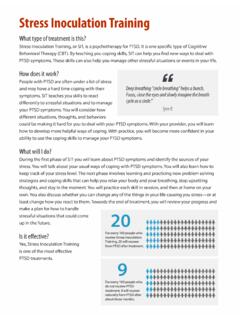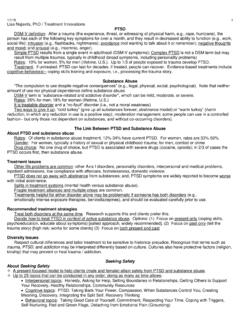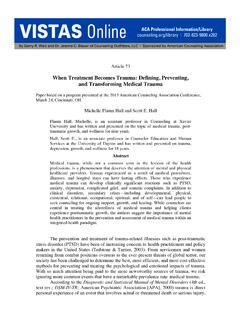Transcription of Cognitive Processing Therapy
1 Cognitive Processing Therapy Veteran/Military Version: THERAPIST S MANUAL Patricia A. Resick, , and Candice M. Monson, National Center for ptsd , Women s Health Sciences Division VA Boston Healthcare System and Boston University & Kathleen M. Chard, Cincinnati VA Medical Center and University of Cincinnati August 2008 Correspondence should be addressed to: Patricia Resick or Candice Monson, WHSD (116B-3), VA Boston Healthcare System, 150 South Huntington Ave., Boston, MA 02130 or When referencing this manual, please use the following citation: Resick, , Monson, , & Chard, (2008). Cognitive Processing Therapy : Veteran/military version. Washington, DC: Department of Veterans Affairs. How to Use This Manual Parts I, II, and III The veteran/military version of the therapist s manual for Cognitive Processing Therapy (CPT) has been organized to maximize the ease with which therapists prepare for and conduct CPT. Part I includes background information on CPT and other common issues related to ptsd that may arise during the Therapy .
2 We recommend that therapists read the entire manual before meeting with patients. Part II includes instructions on each of the 12 sessions. Each session opens with a summary that briefly outlines the format of the session and gives recommended times for each segment of the session. Each segment is then reviewed in detail, with goals, rationale, and sample dialogue. Call-outs are located throughout this section in the right margins of the text to allow therapists to quickly locate specific topics. Sample session progress notes follow the close of each session to facilitate tracking of therapist/patient progress. Relevant patient handouts also follow each session; please refer to the Materials Manual for additional information on handouts. Part III offers information on alternatives to conducting CPT, including variations of CPT and adaptations of CPT for group administration. Table of Contents | Part 1: | Introduction to Cognitive Processing Therapy (CPT).
3 1 Theory Behind CPT .. 1 ptsd as Disorder of Non-Recovery .. 3 Pre- Therapy 3 1. Who Is Appropriate for CPT? .. 3 2. When Should the CPT Protocol Begin?..4 3. Treatment Contracting for 5 Overview of CPT Sessions .. 6 Socratic Questioning Within 7 1. Clarification .. 8 2. Probing Assumptions .. 9 3. Probing Reasons and Evidence .. 9 4. Questioning Viewpoints and Perspectives .. 10 5. Analyzing Implications and 10 6. Questions About the Question .. 10 Issues in Conducting 11 1. Comorbidity .. 11 2. 16 3. Needs of Returning OIF/OEF Veterans .. 16 4. ptsd -Related Disability Status .. 17 5. Religion and Morality .. 18 6. Military Sexual Trauma (MST) .. 21 7. Ongoing Symptom Assessments Using ptsd and Depression 23 8. A Note on Session 2a Bereavement .. 23 | Part 2: | CPT: Session by 25 Session 1: Introduction and Education .. 28 Session 2: The Meaning of the Event .. 58 Session 2a: Traumatic Bereavement (Optional Session).
4 44 Session 3: Identification of Thoughts and 73 Session 4: Remembering the Traumatic 84 Session 5: Second Trauma 98 Session 6: Challenging Questions ..108 Session 7: Patterns of Problematic 118 Session 8: Safety Issues ..134 Session 9: Trust 146 Session 10: Power/Control Issues ..158 Session 11: Esteem Issues ..172 Session 12: Intimacy Issues and Meaning of the 184 | Part 3: | Alternatives and Considerations in Conducting CPT Without the Trauma Account (CPT-C) .. 195 Group CPT 198 | Appendix A: | Glossary of CPT | Appendix B: | Literature on | Part 1: | Introduction to Cognitive Processing Therapy (CPT) Cognitive Processing Therapy (CPT) is a 12-session Therapy that has been found effective for posttraumatic stress disorder ( ptsd ) and other corollary symptoms following traumatic events (Monson et al., 2006; Resick et al., 2002; Resick & Schnicke, 1992, 19931). Although the research on CPT focused on rape victims originally, we have used the Therapy successfully with a range of other traumatic events, including military-related traumas.
5 This revision of the manual is in response to requests for a treatment manual that focuses exclusively on military trauma. The manual has been updated to reflect changes in the Therapy over time, particularly with an increase in the amount of practice that is assigned and with some of the handouts. It also includes suggestions from almost two decades of clinical experience with the Therapy . Theory Behind CPT Theory behind CPT CPT is based on a social Cognitive theory of ptsd that focuses on how the traumatic event is construed and coped with by a person who is trying to regain a sense of mastery and control in his or her life. The other major theory explaining ptsd is Lang s2 (1977) information Processing theory, which was extended to ptsd by Foa, Steketee, and Rothbaum3 (1989) in their emotional Processing theory of ptsd . In this theory, ptsd is believed to emerge due to the development of a fear network in memory that elicits escape and avoidance behavior.
6 Mental fear structures include stimuli, responses, and meaning elements. Anything associated with the trauma may elicit the fear structure or schema and subsequent avoidance behavior. The fear network in people with ptsd is thought to be stable and broadly generalized so that it is easily accessed. When the fear network is activated by reminders of the trauma, the information in the network enters consciousness (intrusive symptoms). Attempts to avoid this Emotional Processing theory of ptsd 1 Monson, C. M., Schnurr, P. P., Resick, P. A., Friedman, M. J., Young-Xu, Y., & Stevens, S. P. (2006). Cognitive Processing Therapy for veterans with military-related posttraumatic stress disorder. Journal of Consulting and Clinical Psychology, 74, 898 907; Resick, P. A., Nishith, P., Weaver, T. L., Astin, M. C., & Feuer, C. A. (2002). A comparison of Cognitive Processing Therapy , prolonged exposure and a waiting condition for the treatment of posttraumatic stress disorder in female rape victims.
7 Journal of Consulting and Clinical Psychology, 70, 867 879; Resick, P. A., & Schnicke, M. K. (1992). Cognitive Processing Therapy for sexual assault victims. Journal of Consulting and Clinical Psychology, 60(5), 748 756; Resick, P. A., & Schnicke, M. K. (1993). Cognitive Processing Therapy for rape victims: A treatment manual. Newbury Park, CA: Sage Publications. 2 Lang, P. J. (1977). Imagery in Therapy : An information Processing analysis of fear. Behavior Therapy , 8, 862 886. 3 Foa, E. B., Steketee, G. S., & Rothbaum, B. O. (1989). Behavioral/ Cognitive conceptualizations of posttraumatic stress disorder. Behavior Therapy , 20, 155 176. THERAPIST S MANUAL Cognitive Processing Therapy : Veteran/Military Version Page 1 activation result in the avoidance symptoms of ptsd . According to emotional Processing theory, repetitive exposure to the traumatic memory in a safe environment will result in habituation of the fear and subsequent change in the fear structure.
8 As emotion decreases, patients with ptsd will begin to modify their meaning elements spontaneously and will change their self-statements and reduce their generalization. Repeated exposures to the traumatic memory are thought to result in habituation or a change in the information about the event, and subsequently, the fear structure. Social Cognitive theories Although social Cognitive theories are not incompatible with information/emotional Processing theories, these theories focus beyond the development of a fear network to other pertinent affective responses such as horror, anger, sadness, humiliation, or guilt. Some emotions such as fear, anger, or sadness may emanate directly from the trauma (primary emotions) because the event is interpreted as dangerous, abusive, and/or resulting in losses. It is possible that secondary, or manufactured, emotions can also result from faulty interpretations made by the patient. For example, if someone is intentionally attacked by another person, the danger of the situation would lead to a fight-flight-freeze response, and the attending emotions might be anger or fear (primary).
9 However, if in the aftermath, the person blamed himself4 for the attack, the person might experience shame. These manufactured emotions would have resulted from thoughts and interpretations about the event rather than the event itself. As long as the individual keeps saying that the event was his fault, he will keep producing shame (hence, manufactured). Social- Cognitive theories focus more on the content of cognitions and the effect that distorted cognitions have on emotional responses and behavior. In order to reconcile information about the traumatic event with prior schemas, people tend to do one or more of three things: assimilate, accommodate, or over-accommodate. Assimilation is altering the incoming information to match prior beliefs ( Because a bad thing happened to me, I must have been punished for something I did ). Accommodation is altering beliefs enough to incorporate the new information ( Although I didn t use good judgment in that situation, most of the time I make good decisions ).
10 Over-accommodation is altering one s beliefs about oneself and the world to the extreme in order to feel safer and more in control ( I can t ever trust my judgment again ). Obviously, therapists are working toward accommodation, a balance in beliefs that takes into account the reality of the traumatic event without going overboard. In a social- Cognitive model, affective expression is needed, not for habituation, but in order for the affective elements of the stored trauma memory to be changed. It is assumed that the natural affect, once accessed, will dissipate rather quickly and will no longer be stored with the trauma memory. Also, the work of 4 Throughout this manual, we will refer to a single patient using the pronouns he and she alternately, rather than saying she/he or him/her. The term service member will also be used as a generic term rather than marine, sailor, airman, etc., and will be used interchangeably with veteran.















